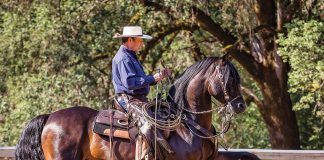Graceland, Elvis’ residence in Memphis, Tenn., has been home to many horses over the years. During a four-day celebration of Elvis’ 74th birthday in January, his former wife, Priscilla Presley, introduced the public and legions of Elvis fans to two of Graceland’s newest equine residents. Max, a 4-year-old bay Standardbred, and Bandit, a 10-month-old chestnut Quarter Horse, were adopted by Graceland to provide the two rescue horses with a home and to maintain the equine presence of the estate that was so important to Elvis.
Max was among six horses saved from slaughter, while Bandit was one of 29 horses that had been abused by their owner, who was court-ordered to give up the starving equines. Bandit was 1 month old at the time. Graceland adopted him nine months later when the court released him.
Max and Bandit are two of four horses that live at Graceland. Sun’s Reflection, a 25-year-old palomino Quarter Horse, is the eldest of the herd. Candy is an 18-year-old Tennessee Walking Horse who was given to Graceland after being retired from the show-ring. Elvis was a fan of the breed and had several Tennessee Walking Horses.
“The legacy of Elvis Presley is multifaceted,” says stable master Alene Alexander, who has taken care of the horses at Graceland for 27 years. “One of the things he absolutely loved was horses.” Alexander explains that today, horse business at Graceland is taken seriously with particular attention to equine care and grooming. “We have an image to maintain and it’s carefully done,” says Alexander. “[The horses] are there to represent a time in Elvis’ life.”
Elvis Presley and Horses
Although Elvis had several hobbies, being with the horses was the most significant. It was also important that his close friends and family were able to share that hobby with him, so he bought them horses as well.
“That was the start of always having horses at Graceland,” says Presley. “He loved the life and energy they brought. Taking care of the horses and going out to the stables was probably the best time of our lives. I think it’s great to carry on that legacy and that tradition. Visitors to Graceland get to see and feel what he experienced.”
Elvis rode often and spent a great deal of time with his horses. Although his favorite was a palomino Quarter Horse named Rising Sun—it is now a tradition to always have a palomino at the estate to represent Elvis’ love for that horse—he was devoted to the care of all of his horses and would tend to them after every ride by personally untacking them and cooling them out.
“The endearing quality to us was that he was truly involved with these magnificent animals,” says Presley, noting that some fans might have a hard time picturing the King of Rock ‘n’ Roll grooming horses.
Elvis especially enjoyed greeting his fans at the gates of Graceland on horseback, riding either Rising Sun or his Tennessee Walking Horse, Bear.
“He would dress for each occasion,” says Presley. “When he got on Bear, he would dress up in a suit and a hat and actually put on a show and gait the horse in front of the fans so he could show off his horsemanship. Fans would go nuts. When he rode the palomino, he would change into western clothes and have races up and down the front lawn of Graceland. The police would be called to direct traffic because 300 to 400 cars would be lined up on Elvis Presley Boulevard to watch Elvis at play.”
Presley reminisces about enjoying the morning view of the horses. “Elvis’ office faced the back of Graceland and the stables, and he would see the horses out there and say, ‘This is the most beautiful sight, to look out my window and see these great animals having fun.’”
Presley and Graceland adopted Max and Bandit to keep that awe and love Elvis had for horses alive, while providing unwanted horses with a home. Both Presley and Graceland are advocates of horse rescue and encourage others to do their part in helping horses in need.
“[We adopted Max and Bandit] to give horses that needed a home a home and to maintain the legacy of Elvis Presley and his love of horses,” says Alexander.
Elvis’ music and films may preserve his legacy as an artist and a performer, but the horses will sustain the image of the man he really was.
This article originally appeared in the April 2009 issue of Horse Illustrated. Click here to subscribe!





